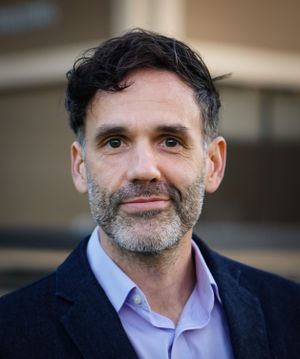How a Survey Course Assignment Connected Students With Contemporary Artists
Students of one Teaching with Primary Sources workshop participant forged connections with contemporary artists and their work in an assignment using the Archives of American Art’s Pandemic Oral History Project
:focal(500x367:501x368)/https://tf-cmsv2-smithsonianmag-media.s3.amazonaws.com/filer_public/c3/29/c32989f5-1c66-4766-88be-85fe762f8727/rees-teaching_siv.jpg)
In Fall 2021, I structured my contemporary art survey around the theme of “embodiment.” As a participant in the Archives of American Art’s Teaching with Primary Sources workshop, I developed an assignment to help my students explore this topic through archival sources. Already a salient concept in contemporary art, embodiment seemed even more urgent in the context of the COVID-19 Pandemic. Bodies define our place in physical and social worlds, they mediate our experience of visuality and our representation as viewed subjects—and, as the pandemic starkly revealed, they make us vulnerable, both physically and socially.
I designed the assignment in conversation with the Archives of American Art’s Pandemic Oral History Project, an extensive collection of interviews with artists and art professionals. I aimed to create a project that would meet the course’s objective of learning “practices and procedures in conducting art historical research” while giving students a wide latitude in exploring personally-relevant topics as they addressed the theme of embodiment. Instead of a more traditional research paper, I structured the assignment as a critical reflection to encourage students to encounter contemporary artists as actual humans living and working in the same world that they inhabit, sharing similar experiences during the pandemic.
Students started by exploring the interviews in the Pandemic Oral History Project and selecting any artist they found interesting. Then, they did some basic research—looking for artists’ websites, social media accounts, or gallery sites, for example—to identify one specific work by the artist as the subject of their critical reflection. To complete the assignment, students wrote a critical reflection about the artwork, using the Pandemic Oral History interview as a focal point. The assignment asked students to investigate how the artwork relates to the artist’s life experience, expresses their identity, and engages with their broader cultural context.
The idea wasn’t simply to have students report on what artists are doing during the pandemic; indeed, most of the works that students wrote about were created before the COVID-19 crisis began. Instead, the critical reflection invited students to learn more about the artists’ perspectives and experiences through their interviews, and then to develop their own analytical perspective based not only on a narrative biography, but on a deep exploration of an artist’s work. I wanted to give students just enough structure to feel supported, so I provided a list of questions to consider and a sample outline, but otherwise I left it entirely up to them to engage with whatever they found most meaningful. The starter questions encouraged students to explore the artwork’s form, content, and concept, but also their own perspective: “What effect did the artwork have on you as a viewer—whether considering aesthetic, emotional, educational, or other effects?” The Pandemic Oral History Project provided our course an ideal inroad to archival research. First, the freshness of the material countered students’ expectations about the relevance of archives for research in contemporary art. Despite the challenges of studying living artists whose papers are unlikely to have already entered collections, the Pandemic Oral History Project revealed the important role archives can play in documenting contemporary art as it unfolds. Second, the project’s wide range of interviewees resonated with my diverse class. Coming from the perspective of embodiment, this was a particularly meaningful aspect of the assignment for many students whose experience of art history has often not included very many artists that look like them. Seeing artists detail their own experiences of race, gender, sexuality, nationality, and other aspects of identity was an important opportunity for students to recognize many of their own experiences and concerns—especially in the context of the COVID-19 pandemic and its unequal impacts on different populations—and to learn from how artists have grappled with these issues in their work.
I was surprised to see how often students found something personally relevant in their artist’s work. A common theme in the critical reflections was a sense of resonance—whether with an artist’s experience or process or work. Many students were impacted by the revelation that artists are real people undergoing many of the same experiences that they are facing. One student noted that learning about Alisa Sikelianos-Carter’s work
“opened my eyes” to the realization that contemporary art could be “so relatable to me.” Another student wrote that it was empowering to realize that both she and DEMI were “just humans living in a pandemic.” The list of emotions that DEMI shared in her interview, including “sadness, desolation, hopeless, fear, faith,” and many more, resonated with her own experience during the pandemic. A third student was inspired by Chitra Ganesh to develop “a creative spirit within myself that is aware, involved, and engaged.” None of these are outcomes that I suspect my students would have anticipated from conducting primary source research. This assignment not only helped my students develop skills in archival research, but also encouraged them to recognize the humanity underlying archival collections and the continuing relevance of the human stories they preserve.
This essay originally appeared on the Archives of American Art Blog and was supported by funding from the Dedalus Foundation.
/https://tf-cmsv2-smithsonianmag-media.s3.amazonaws.com/filer_public/a9/38/a93853f7-5fa3-44c4-b2c3-366d7933efb3/demi_siv-slide.png)
/https://tf-cmsv2-smithsonianmag-media.s3.amazonaws.com/filer_public/77/64/7764c62c-fc67-4b4b-8e61-e377e938a798/sikelianos-carter_siv-slide.png)
/https://tf-cmsv2-smithsonianmag-media.s3.amazonaws.com/filer_public/d6/7b/d67be9d7-7985-49db-82ac-645a9ee12ffd/ganesh_siv-slide.png)
